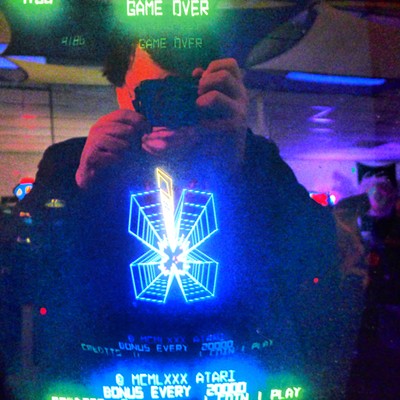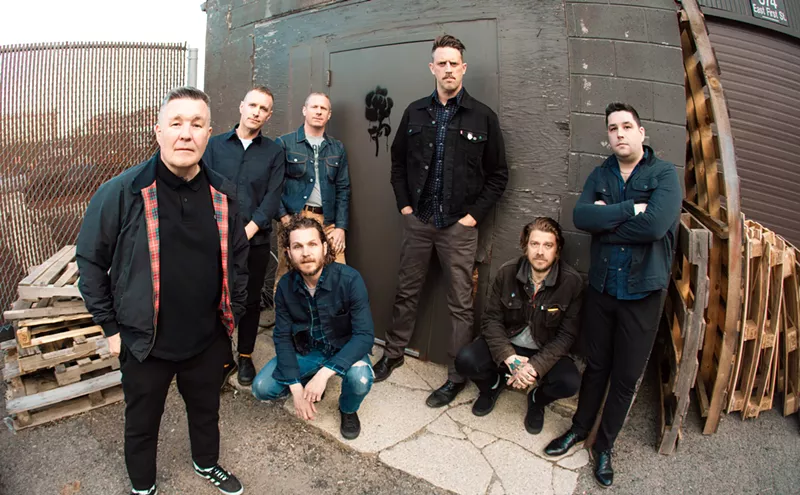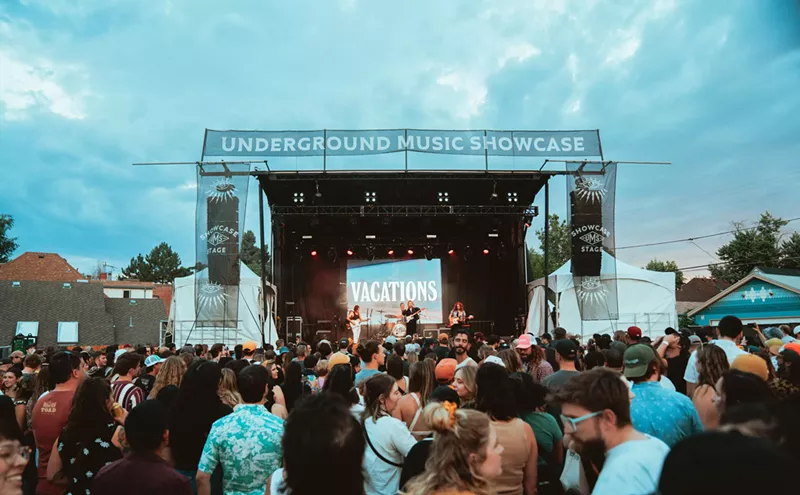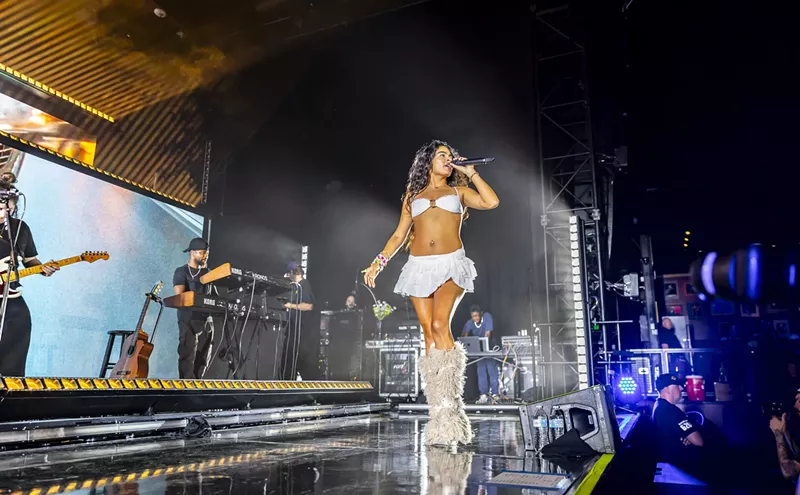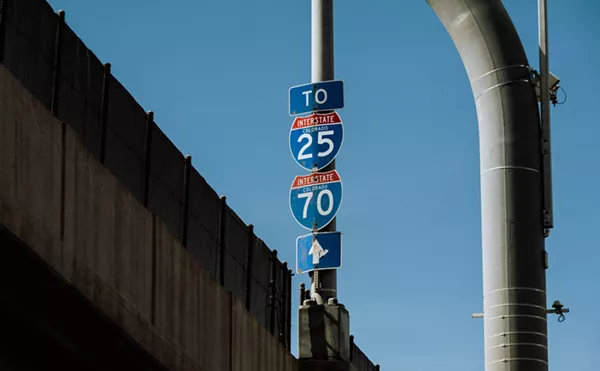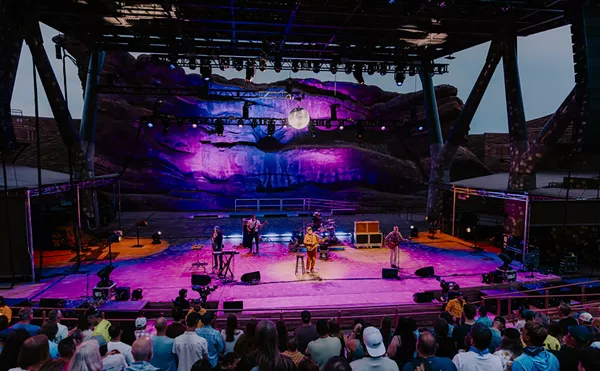In a scene oversaturated with bands mining the 1960s, Shannon and the Clams manage to stand out in stark contrast to their peers. That's partly because their songwriting is simple and strong, but mostly because of Shannon Shaw's powerful, soulfully melodic and emotionally gripping voice. Shaw sounds like she took a time machine back to 1965, burned through producers at the Brill Building and Motown, then set out to do make music on her own, on the heels of getting ditched by the love of her life.
See also: - Sunday: Shannon and the Clams at the Larimer Lounge, 6/30/13 - The ten best concerts in Denver this weekend - Ten essential albums of the 1960s
If the Clams' last album, the monumental Sleep Talk, was a bracing indication of potential, the act's latest release, Dreams in the Rat House, is perhaps a notch better. Shaw's talent is no studio trickery, and live, she's even more charismatic and thrilling. Hailing from the Bay Area, Shannon and the Clams have been honing their craft to a gritty and visceral perfection. We recently spoke with the band's guitarist and co-songwriter Cody Blanchard about H.P. Lovecraft, Del Shannon and the recurring theme of transition from childhood in the band's lyrics.
Westword: Were you at the house party shows the band played before you joined?
Cody Blanchard: Yeah, I used to see them play all the time. I actually played drums for a couple of shows in the very early days. I had been in a band with my sister in Portland, and I played drums in that.
At some point you moved from Portland to the Bay Area? What took you there?
That was in 2005 or 2006. I went to art school. It wasn't very good. It was pretty shitty, so I left.
What kind of art did you do?
I was writing -- stories. I just don't think art school is the right place for literature. I wrote little Twilight Zone kind of stories.
So kind of science fiction, kind fantasy, a bit of horror?
A little bit surreal and kind of science fiction. I've always been drawn to weird, sad twists at the end.
How did you get connected with doing music?
When I was a kid, I used to write songs on an old synthesizer and record them onto a tape. Then I started writing stories in junior high. And I got into trouble for that. I wrote these really long stories, but they were really violent and weird. It was dumb because they would give me a bad grade, but I wrote more than anyone, and I feel like the stuff I was writing took way more effort than what anyone else was doing. The subject would get me a bad grade. I guess when you're a kid you feel like you can write anything because you can make anything happen. I liked Troma movies and Evil Dead when I was a kid, so I wanted to write violent, horror, drug stories.
What drew you to Troma movies and the like?
I don't know. They were just so off-the-wall and over-the-top. There was a video store down the street from my house, and I used to go there all the time and go into the horror and sci-fi section, and look at every movie box, and read it, and think what it was about. They had a video arcade on one side, and we would play Mortal Kombat and stuff and rent videos. We would save coins to rent those videos and buy candy.
My two best friends are brothers, and they lived next door to me, and their dad was this carpenter guy, and he was stoned all the time. But I didn't know it because I didn't know what marijuana was. He was just always high and smoking cigarettes. He would rent all these really crazy B horror and sci-fi movies from the '80s and '90s, like Evil Dead, Waxwork and They Live, and stuff like that.
Normally, I wasn't supposed to watch that stuff but I would just go to their house and sleep over and watch those movies. I think because their dad would rent that stuff, we just got into Troma and horror movies. Also, when I was little, my dad had a lot of tapes of '80s sci-fi action movies that he'd take off of TV, like Predator and Big Trouble in Little China, Terminator and Robocop. I think I was watching those when I was five or six years old.
It's kind of insane but I think that's why I love all that stuff. So yeah, going back to [music], I played in a band in high school that started as a street punk/pop punk band, and that's when I learned to play bass and guitar though I played keyboards for a long time before that. I quit doing that and started writing more, but then I started that band with my sister. Now that I think about it, it was called Cherry Bomb.
When you moved to San Francisco, how did you meet Shannon Shaw?
We all went to art school together. They used to practice at my house because we had a big house with a drum set. It was the only place they could find to practice.
Obviously you'd played pop punk before, so it wasn't a huge transition to going to play what you do now.
I hadn't played for five years. I was just writing stories. I was always writing music when I was a kid, and my dad was in country bands and classic rock cover bands. When I joined the Clams, I'd really gotten into Hank Williams and Woody Guthrie and played that kind of stuff, writing funny little country songs.
The title of your new album is Dreams in the Rat House. Is that a nod to H.P. Lovecraft?
Absolutely. I love his writing. I mean he's a terrible writer, but his subject matter is so unbelievable. So good. So inventive. So far beyond almost anything that's come out since then. I think science fiction is so tame and stupid compared to the stuff he was doing.
I was always wowed by Twilight Zone and Star Trek, but when I read Lovecraft, I felt that what he was writing about was so far beyond other writers. Just writing about cosmic, psychedelic subjects that are so broad and far-reaching. I feel like through his characters, you only get a hint of the larger, subterranean, eons old world. It's such weird, dark fantasy.
He's a master of the art of suggestion. Edgar Allan Poe and Arthur Machen, and perhaps to a lesser extent, Charles Maturin and J.K. Huysmans were his influences in that regard.
Yeah. I have yet to read that but I've heard a lot about it.
Why do you feel that title suited this album?
I think it was just an interesting title. Our drummer that just quit turned me on to H.P. Lovecraft, and I love that story "The Dreams in the Witch House." The Rat House I think was a combination of all our interests.
For me, Ian [Amberson], our old drummer, and Shannon, the "Rat House" is piece of an old property that her parents lived on and they built this house there -- a creepy little shack that she was always sort of scared of and fascinated by when she was a kid. It was sort of a haunted shack [in Napa] they called The Rat House. The record is about childhood issues or things changing from childhood. The title is a fusion of both of those facets, I guess.
That song on the album "Rip Van Winkle" is like a metaphor for that whole thing because he went to sleep and woke up years later, and the world had changed, but inside his head, he hadn't, and had to navigate the new reality.
Yeah. I feel like there's a theme in Shannon's songs of getting away from the home where you grew up, and revisiting it, and it has changed. Sometimes you don't really notice it, but then one day, you realize so many things have changed. Or not being aware of the way things have changed.
There's that song "Ozma." Is that a reference to the L. Frank Baum character?
That was the name of a dog that died right before we recorded that record. It was Shannon's dog. We were on tour, and the dog had always lived on the property in Napa. Her little brother brought it to Oakland, and it ended up getting into this rabbit cage and at all the rabbits. It sort of choked on them and then it got a lung infection from not being able to digest the rabbits properly. So that song is a tribute to that dog. There's a single 45 of that song with a photograph of Ozma on the back.
In the liner notes for "Heads Or Tails," it says there are backing vocals by Paula Frazer. Is that the same Paula Frazer from the slowcore band Tarnation?
Yes, the same one. Shannon sang with her in this group called the Golden Girls. It's kind of an R&B/soul revue thing. They've all quit by now because they didn't get along with the guys that ran the band. Anyway, that's how they knew each other, and Heidi Alexander from the Sandwitches and the Fresh & Onlys was in that, too.
There's a bonus track on the album, "Runaway" by Del Shannon. Why did you want to do that song in particular?
We have been playing that song for like three or four years, and we never recorded it. Well, we recorded a bunch of cover songs, but we've never released them. It's just such a spooky, weird song. I don't know that we did it justice, but we did an okay version. Del Shannon has such a weird history, I think. He's got a bunch of great songs but he's such a weird, underdog character.
In the thank you list you mention Uzi Rash.
Uzi Rash is done. It's over. I think lyrically Uzi Rash is really great. I think it's hard to get a hold of their lyrics in any form or understand them. Max [Nordile] writes excellent lyrics, and now he's in the Trashies. In his Uzi Rash lyrics, there's a lot of Lovecraft type stuff and conspiracy theories, reptilians, pyramids and Illuminati type stuff.
They covered such a broad range of sounds. He put out something like 25 albums in five years. He would play with a different band all the time. There were about ten different people in rotation. Sometimes he would do a show where he would play one song for like twenty-five minutes. It was just really fun and free and wild.
Sometimes he would improvise. It was always chaotic and free-wheeling. It was really fun to play in because there was a lot of room to screw around. I played a twelve-string in the band for a while but I would de-tune it, so it would sound messed up.
Obviously you had a hand in the layout, design and artwork for the album.
Yeah, I did the front cover.
The inside photo looks like something a black metal band would do.
Totally.
What was the concept for the packaging?
I wanted to do a montage cover that was a mix between those '80s movie posters that were like those paintings that were supposed to be self-portraits and then the main character is in sort of water colors. Also a lot of Bollywood movie posters that are paintings that are sort of melting montage things. That and like a '70s ELO or country album cover. Maybe a little bit of The Wizard of Oz in there with the crystal ball shape. That and The Secret of NIMH. There's sort of a Glinda, rainbow bubbles sort of thing.
We weren't really sure what to do. Usually we do a lot of mock-ups and pick one. And that one seemed to be the strongest. Our drummer actually made this huge diorama thing, and part of that ended up being the back cover. It's like a huge forest scene. It just didn't look how he wanted it to. It's not really his medium.
We didn't have much time, so it didn't turn out how he wanted, but we put it on the back cover because it's kind of cool. The lettering on the front was designed by Caitlin Galloway. She did the lettering for Grass Widow. I was trying to explain what I wanted -- something Victorian, kind of like musical notation and The Wizard of Oz. It's so perfect.
Follow @Westword_Music


